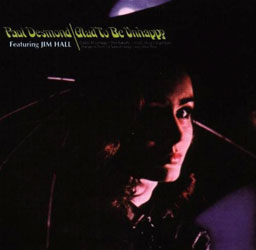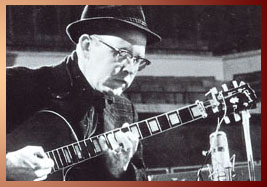

|
Soundclip:
|
|
Jim
Hall's Solo on:
"Poor Butterfly"(Hubbell-Golden) |
|
From 1959 through 1965, Jim Hall recorded a series of wonderful albums with alto saxophonist Paul Desmond. Though I suppose that there exist 'camps' of Jim Hall fans who would argue that the recording, done during the same time period, with Sonny Rollins, originally titled "THE BRIDGE," offers the 'best' Jim Hall one can hear. I'm not so certain that I would agree. For me, I'm especially fond of the following recordings with Desmond, those being: "EASY LIVING," "TAKE TEN," and "GLAD TO BE UNHAPPY," all initially done for the RCA Victor label. These recordings define an approach to the guitar, one born of grace, warmth, subtlety and moreover the usage of space and silence.  These recordings also offered interpretations of some of our most beautiful standards, some extremely well known, while others are perhaps a bit more obscure. That noted, I've chosen to offer Jim Hall's 2-chorus solo on, "Poor Butterfly" as an example of some of his finest playing. These recordings also offered interpretations of some of our most beautiful standards, some extremely well known, while others are perhaps a bit more obscure. That noted, I've chosen to offer Jim Hall's 2-chorus solo on, "Poor Butterfly" as an example of some of his finest playing.
When I think of Jim Hall and try to describe his style and approach, one quality which I always mention is his development of ideas. A style where everything played has a purpose and a direction. I suppose he's often been described as a very 'thoughtful' player, but I would not take this to mean that he's a 'cerebral' player because his playing has great heart and soulfulness. His lines weave themselves into one another without ever sounding forced or contrived. To these ears, he always sounded completely comfortable playing in a context without a piano. Something which, for most others, might have been a terrifying experience, facing all that 'air' in the texture. Hall never seems to be afraid to let his lines and phrases 'sing' above the moving bass, allowing the notes to simply speak for themselves. That 'harmony' can be simply defined by two moving lines, this is heard as effortless in his hands. The tune, a ballad, "Poor Butterfly," appears in the classic [A][A'] form with each [A] being 16-bars in length. Jim's solo follows two choruses by Paul Desmond. If one just glances over the solo in total, it's rather remarkable to observe that it 'seems' that Jim Hall, of all people, has played a LOT of notes. Perhaps more remarkable is that the solo, when listened to, never really 'feels' like a LOT of notes have been played. In offering this particular analysis for the website, in addition to the normal 'musical' considerations, I'm also going to make note of some specific guitar 'mannerisms' which appear in this improvisation as well. When Paul Desmond concludes his solo, we are left with a most spare texture, simply, a guitar trio. When one is as comfortable in a setting such as this, as Jim Hall obviously is, one can take great advantage of the space and create an elasticity which blurs the bar lines. One can even alter the 'character' of the chords to suit one's own sense of harmony. One of my favorite examples of this technique, employed by Hall, occurs in bars 17-18 of Chorus [2] during a brief chordal passage in bars 17-18. The chord color, as it appears in the song, is clearly Bbm7.....but, if you listen carefully, you can hear that Jim has used a voicing which could best be described as Bb7(9, 13)[a dominant 7th chord] and you clearly see that there is a D-natural as opposed to the Db one might expect. Below the D-natural is an Ab on the 'A'-string which makes this a difficult voicing to finger for many guitarists. As this same 5-note voicing moves down one half-step in the next bar, it becomes an Eb7(#5, #9-b9) voicing. So, what he has done is simply to create a V7 of a V7 device, instead of the expected iim7-V7. One can see this device employed often by our greatest pianists as well. There is another brief example of this device just as the solo ends in bar 32 of Chorus [2], you see Jim employs the tritone of Bb-E which clearly indicates that he's using a C7 chord as opposed to the Cm7 he has used at other times in the same spot.  Again, when you're in a trio setting and you're in control of the harmony, making a simple spontaneous adjustment like this is always possible and adds tremendous variety. When playing with friends in a trio context, try giving this device a chance and see what happens. Again, when you're in a trio setting and you're in control of the harmony, making a simple spontaneous adjustment like this is always possible and adds tremendous variety. When playing with friends in a trio context, try giving this device a chance and see what happens.
For harmonic elasticity with lines, one might take a look at the passage in bars 15-16 of Chorus [1] where the chord is clearly Bbm7. Rather than simply playing out the remainder of those bars in a modal(Bb Dorian) fashion, Hall 'sandwiches' the fundamental harmony(a 1/2-step above and below) by outlining a Bm7(9)(arpeggio/line), and as he makes his transition 'back' to Bbm7, in bar 16, he begins to outline Am7(9) before 'sliding' back into a harmonic posture which seems to indicate a V7(F7) voicing. You can see/hear this as the last four 16th-notes are C, A-natural, Ab(the #9), and F. It's a beautifully executed device and, in my view, it's a way of inserting the 'sense' of V7(Alt.) chord where it really doesn't exist on the written music. Some of the 'guitaristic' devices he employs such as his version of 'sweep' picking can be heard in Chorus [1], bars: 5; 6; 12; 17-19; 21-22; 31 and in Chorus [2] in bars: 21-22; and 25-26. There are also some wonderful double-time 'bebop' lines played in Chorus [1], bars: 9-11; 25-28 and in Chorus [2], bars: 11-12. Check-out the terrific usage of double-stops(intervals like 3rds, 4ths, and tritones) in Chorus [1], bars: 22-24; 32 and in Chorus [2], bars: 7-8; 10; 19; 25-26; 32. For rhythmic variety, Jim employs various triplet figures throughout, in Chorus [1], bars: 8; 14; 23-24; 29-30 and in Chorus [2], bars: 1; 17-18; 23; 29-30. One final purely technical guitar note, during this period of Jim Hall's playing, it seems that he was refining and defining a particular style of picking/non-picking which has influenced some of today's most significant guitarists: John Abercrombie; John Scofield; Pat Metheny; and Bill Frisell just to name a few. You can clearly hear that many of the lines are played in a most legato fashion with his left-hand doing most of the work while he eliminates picked strokes from the right-hand. It creates a rather 'slippery-slidey' feeling and, in my view, enables the lines to 'swing' more because the sharp attack of the pick is now absent. If you're searching for ways to make your playing have a greater sense of swing, enable your time to feel more elastic, try eliminating picked strokes in this fashion and see how it goes. All in all, this is a really wonderful solo and comes from my favorite period of Jim Hall's fantastic career. I must confess again that the recordings with Paul Desmond are my personal favorites as well. I am hopeful that you'll give them a try if you're unfamiliar with them. As always, please enjoy this transcription with my best wishes. |